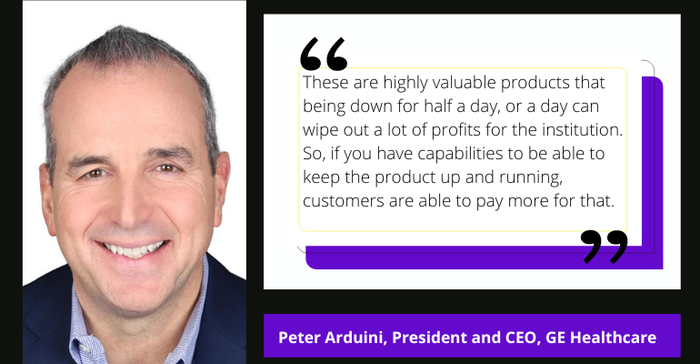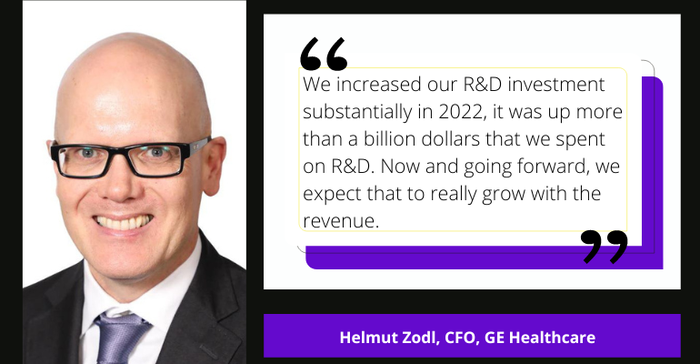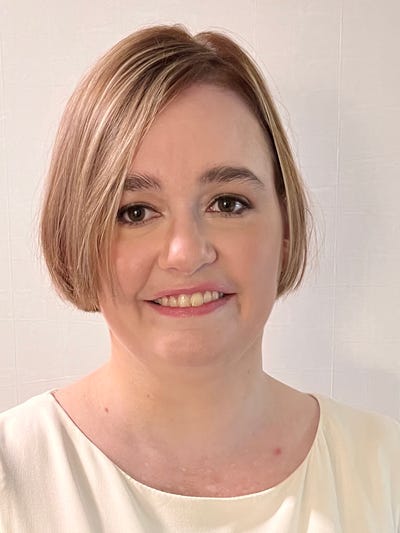Why GE HealthCare Is Bullish About 2023 Growth
GE HealthCare expects to see between 5% and 7% growth in its first year as a standalone company. Here's what makes management so bullish about the year ahead.
February 1, 2023

GE HealthCare's first earnings call as a solo company gave investors many reasons to be confident in the company's growth outlook for 2023. The Chicago, IL-based company, which completed its spinout from General Electric in early January, expects to see between 5% and 7% growth this year.
CEO Peter Arduini and CFO Helmut Zodl pointed to a healthy order backlog and robust demand, improved pricing, new product capabilities, high-growth products, and easing supply chain pressures as some of the rational for the confident 2023 outlook.
"The energy across the company is palpable, and there's tremendous excitement and focus around our purpose to create a world where healthcare has no limits," Arduini said during the company's fourth-quarter earnings call this week.
GE HealthCare's visibility into backlog and continued demand
Not only does GE HealthCare have a healthy backlog heading into 2023, but Arduini and Zodl emphasized the good visibility they have into that backlog.
"With carrying a little bit larger backlog than we normally do one of the advantages of that is we actually have greater visibility out into the distance about what the deals look like, what the margin is on the deal, the timing thereof, and one of the things our operating teams in each of the segments have done a very nice job is actually speaking with customers and getting all the install-based products planned out as far as we can go," Arduini said.
In many cases, that means a couple quarters out, which is is longer than the business has historically done, he said.
"But we did that purposely just based on some of the questions within the macro environment," Arduini said. "And so that gave us more confidence here about what customers want, when they want it, and we've got some pretty good visibility into that."
The company has good visibility into its other products as well, such as ultrasound and products with more flow capabilities, he added.
Arduini also provided some context regarding the demand GE HealthCare is seeing across the geographies it serves.
"In Europe there's still robust demand ... China has obviously been a topic in the news and although COVID was challenging in Q4 there was quite a bit of investment that we saw going into imaging in particular and in ultrasound and we believe as the market there works through some of the challenges with COVID and Q1, but there's just a lot of pent-up demand," Arduini said. "If you think about '22 and even '21 with some of the lockdowns, there's a lot of people that have a lot of procedures to be taken care of. And in the United States we were pleased to see with different customers ... are seeing improving conditions. It doesn't mean that they're back to, say, '19 levels, but it means that we're seeing improvements in labor costs, the demand or backlog meaning the need for imaging procedures both in our interventional diagnostic and ultrasound modalities is still at a record high.
One thing medtech executives and analysts always keep an eye on, particularly in the United States, is how healthcare systems are prioritizing capital expenditures.
"All indications are that people are being prudent and prioritizing for sure, but many of the technologies that we offer tend to be prioritized to the higher end of the list," Arduini said. "And what customers tell us is, in many cases, that added productivity to get patients diagnosed faster, sooner, get them healthier and out of the system is one of the key attributes that we bring. So, we're cautiously optimistic, but I'd say with our large backlog that we have starting the year we feel good about the horizon that we see here over the next couple quarters."
Is the supply chain really improving?
"We've talked about improving supply chain, but again, improving isn't back to, say, the good old days. All our input costs have some added cost to them, it's why we put a lot of focus on variable cost productivity, we're carrying some inventory from spot buys and things that [are] higher rates, and we're going to see much of that continue into '23," Arduini said. "But we have good visibility to it, and I think as we see how the economy plays out and how that plays out relative to inflation, we'll have better insights about what we can do about it. But again, our first half visibility looks quite good at this point in time, we're optimistic that we're going to continue to see improvements throughout the year."
The price is right

When it comes to pricing, Arduini said GE HealthCare's job is to bring more value to its customers to help address their biggest pain points. So, the more the company can create products that solve those bigger issues, the more it can fairly charge its customers.
That goes for both equipment and services, he said.
"We're also investing in innovative new services, whether they be different types of remote capabilities ... these are highly valuable products that being down for half a day, or a day can wipe out a lot of profits for the institution," Arduini said. "So, if you have capabilities to be able to keep the product up and running, customers are able to pay more for that."
The other aspect of services, as it relates to pricing, is that as the products advance and include more digital capabilities, the related service contracts for those advanced systems will also have a tailwind of better pricing down the road, he noted.
"We also have good visibility on price in our backlog," Zodl added. "We already know what is going to happen and ship here over the next quarters and how much price is in that backlog."
What are GE HealthCare's capital allocation priorities?

"Investing in the business is a key priority," Zodl said. "We increased our R&D investment substantially in 2022, it was up more than a billion dollars that we spent on R&D. Now and going forward we expect that to really grow with the revenue. When you look at the rest of the capital allocation, obviously this is a strong cash-generating business, I'm talking about 85% or more free cash flow conversion, and we will use and deploy that cash to continue to invest organically into the business but also ... [inorganically]."
Just a week after its spinout, GE HealthCare agreed to acquire Imactis, a French developer of CT interventional guidance technology. Financial details were not disclosed, but the company said it plans to fund the transaction with cash on hand. Zodl said Imactis is one example of the types of M&A the company will be looking to execute on in the future.
"Pete and I spent a lot of time with our M&A team to look at opportunities because I think it's important for us to see what is out there and make sure that [we have] good transparency and visibility and then make decisions that are going to be be very disciplined," Zodl said.
About the Author(s)
You May Also Like



.png?width=300&auto=webp&quality=80&disable=upscale)
